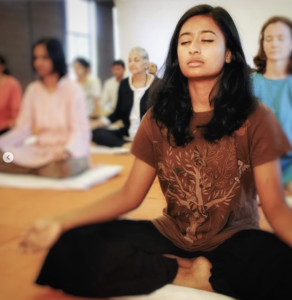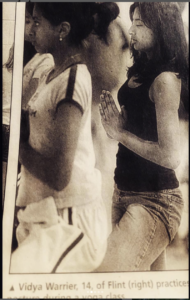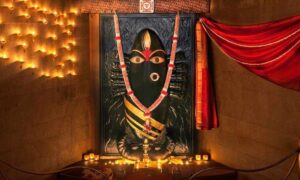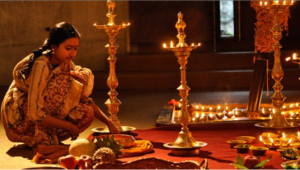Vidya Warrier
In this Spring 2021 Edition of JaggeryLit. Arts Editor Srividya Ramamurthy had a fireside chat with Vidya Warrier. Her story is an amazing journey. She is an excellent Kathak dancer, a Hatha Yoga practitioner. She has spent years learning both and has found ways and means of integrating these in a wonderful way to bring in awareness on culture, heritage and much more. This young woman is an inspiration to many of us. Her conviction and taking the path often less traveled is truly inspiring. Well, let’s talk with Vidya Warrier and hear all about it.

Vidya, thank you so much for taking your time to talk with us. I am a bit confused on where to start. Let’s start with dance. Kathak – When did you start learning? Can you also give a background on the art form?
Thank you so much for having me. I consider this as an honor. I started to learn to dance from the age of 5. My parents had me learning Bharatanatyam. However, I then transitioned to learning Kathak when I was 8 years old.
Kathak comes from the word “Kathakkar” or, one who tells stories. Kathak originally is an art of storytelling. It began in the temples and villages of North India, where Kathakkars would travel from village to village sharing stories of various kinds.
When the Mughal invasion occurred in North India, this art entered the royal courts as a form of entertainment. It is in the presence of the Moghul royalty that Kathak gained a Persian influence or “andaaz”.
Today Kathak is a synthesis of both its traditional Hindu roots, as well as Mughal influence. I suppose one hidden beauty also lies in this embrace or “dance” of two otherwise highly conflicted religions. For me personally, I find my emotions relate more in the Hindu aspect. However, I source vast technical nuance and style from the Moghul shades of the art.
Kathak also has close ties with the Sufi tradition, particularly in the swirling or dervish dances. They say Romanian dances and even Flamenco dances also have similar steps because of the ‘gypsy’ tribes that traveled through North India and picked up some shades of Kathak.
Kathak tends to be ‘circular’ in its general landscape. There is also a hugely under-appreciated subtlety in Kathak, one which requires mastery and subtle control of certain muscles in the torso, limbs, and face. But today, these nuanced pieces often get sidetracked. The jazzier pirouettes and fast footwork of Kathak are more popular.
That’s interesting to learn. Thank you for taking your time to explain how Kathak as a dance form has evolved and adapted. You are also a Hatha Yogi. Can you talk about when you started learning yoga?
I started learning yoga when I was 12 years old. In the year 2000, my mother had taken a yoga program with Sadhguru Jaggi Vasudev – Yogi and mystic from South India.
Soon afterward, I received Hata yoga training and basic children’s yoga.

I was not a dedicated 13-year-old yoga practitioner at all! And I used to practice occasionally. Still, even that minimal connection with Yoga was a tremendous support I feel. Growing up in an environment where my parents and family friends were completely immersed in a yogic lifestyle had a positive impact. Although I did not have a clue of what Yoga was, there was a constant reminder that there is “more” to life than what we do every day. And, that the source of happiness is inside me somewhere, not out in the world where everyone thinks it is.
For a teenager growing up in the U.S.; I cannot tell you how invaluable that perspective is, even if it is just an idea.
How was the experience of growing up in conflicting ideologies? The yogic lifestyle at home vs. a teenager growing up living life in a Western lifestyle.
Even before my parents started practicing yoga, we (me and my sister) had a very traditional Hindu upbringing. Our “playtime” was to dress up like gods and goddesses and enact stories from the great epics of India, like the Mahabharatha or Ramayana! And hours upon hours of dancing… a lot of singing too. We lived in our own, happy world.
When I got into Junior High, of course, there was a social pressure to assimilate. While kids my age were beginning their first relationships, their first explorations with alcohol and drugs… my parents were whisking us off for the weekend to volunteer for the next yoga program!
Eventually, I did have to play the part to fit into the Western world. I tried to fit in. That is not an age where “being yourself” is respected much! So, I went with the flow. After a certain point, something in me did not feel comfortable anymore. A part of me recognized my own “act,” and was not ok with it. When I reached a certain peak of struggle, I started meditating. Things changed a lot after that.
Looking back, I think Shoonya and Kriya (yoga practices offered in the Isha Yoga Program) became available to me when I needed it the most, when the conflict hit a certain peak. That is not just for me, many people I know have shared that yoga came to them when they truly needed it. Maybe, it has an intelligence of its own.
You moved to the Isha Yoga Center in Coimbatore India, right after High School ? Wow! What made you choose that over a regular college undergrad?
After I turned 15, I started practicing a meditation called Shoonya, offered by Sadhguru. It is a conscious practice of “non-doing” – sitting still.
Once I started shoonya, I became a much more dedicated yoga practitioner. I did it every day, without fail, along with some basic kriya yoga. While I was in high school, my lunch breaks were usually in my car! I would practice shoonya, then eat fast just in time to make it into the school for 4th period.
What amazed me about meditation is the simple beauty it brought into my life. You close your eyes and the entire world melts away. And then you come back totally new and refreshed. I was deeply intrigued by this silent world.
Moreover, I felt a sort of urgency to explore yoga under the guidance of my spiritual Guru – Sadhguru. I did not want to waste time on anything else. I felt invigorated to learn more about the ancient sciences of our culture. Hence it was a natural choice – in fact it wasn’t even a choice. I knew I had to go to India to know more.
If the thirst for knowing is that intense then there is definitely no stopping that. Can you describe your experience at the Isha Yoga Center in India?
Isha Yoga Center has been designed by Sadhguru for meditation and self-transformation. The center is located near Coimbatore, Tamil Nadu, India. It is such a beautiful place at the foothills of the Velliangiri Mountains. A fundamental aim of Sadhguru’s life was establishing Dhyanalinga – a “multi religious” shrine. It represents consciousness beyond all religion, caste, and creed. In fact there are no rituals or poojas. It is maintained in silence because it is made purely for meditation. I would encourage your readers to read more to understand this in greater detail. The Yoga Center is designed like a beautiful ornament for the Dhyanalinga, it revolves around that space. It is a Kshetra (sacred land). The ambience, the food, and the lifestyle in the Yoga Center is set up for spiritual growth. It involves super intense work along with yogic practice. I found myself in new situations every day. I was learning constantly and often in situations out of my mental, emotional, and physical comfort zones. Sadhguru has several initiatives that are all run 100% by volunteers. So, there is always a constant of working in multiple projects all the time. Yoga practices give one a sort of strength to keep up with the intensity of work. I fall short of explaining the experience in words. It is truly one of its own experiences that has helped me in many ways beyond my imagination.

Being a part of Sadhguru’s initiatives has helped me to approach the world in a more “wholesome” way than before. In society, there is a tendency to look at everything in parts. “Mine,” “yours,” “this,” “that.” In a capitalistic world, numbers rule. Yes, numbers have their place. But what I discovered with Sadhguru and his work is more toward seeing everything as “One.” “Yoga” means Union. Oneness of everything. So, when you are doing volunteer work, you strive to recognize the oneness in everything. That makes work much more joyous and harmonious.
Even now, I attempt to bring that element into my life every day. It makes work, relationships, and life overall much more effortless, with less friction. I go about my day with more joy and that just flows into my work.
Vidya!! Truly inspiring. Path less traveled at that young age. But has given you so much maturity and wisdom. So how many years did you spend in India? Did you also travel and visit any sacred spaces or temples and what was your experience?
I was in the ashram for 11 years. Within a few months of moving to India, I had the opportunity to visit the Himalayas. That trip certainly set the tone for my life there.
Himalayas are unique because hundreds, if not thousands of yogis and sadhus have spent time meditating there. I was part of an organized yatra or pilgrimage which covered regions from Haridwar, Badrinath, Kedarnath, Rishikesh and many other temples on the way. This was my first exposure to Indian spirituality in all its rawness and profoundness. Subsequently I visited Mt. Kailash. Kailash has been held as a spiritually significant place by multiple religions. Our trip took us through Lake Mansarovar in Tibet.
Oh, and Kashi- the “city of light” stole my heart! There is a rich background to this space that many people are unaware of. In fact, the entire city was created in the form of a sacred mandala. Personally, it was here in Manikarnika ghat that I witnessed a cremation ground for the first time. It really changed my perspective and ‘relationship’ with dying.
But one incredibly unique trip I took was to Guwahati, Assam. The powerful goddess Kamakhya temple is here. The rural parts of northeast India are some of the country’s most gorgeous and untouched places.
I also had the opportunity to travel to various South Indian temples. The Pancha Bhoota Sthalas, or the five temples which represent the five elements, are brilliantly placed in a certain geometry across South India. Being a Malayalee, I naturally had opportunities to visit temples of Kerala. Kerala is one of the few places where temple traditions are maintained in its purity.
Samadhi spaces – or places where yogis and saints chose to leave their body – dot the subcontinent from North to South. These spaces help one realize that we can not only live consciously, but we can also die consciously. It sounds a bit odd from a Western perspective, but this knowledge of “conscious” dying is prevalent across Eastern cultures. Needless to say, these powerful spaces are hugely energetic. They inspire you on all levels – physically, mentally, and spiritually – to strive for the highest.
Because I have traveled and moved so much over the fifteen years…. I don’t usually miss things very much. But if I miss anything about living in India – it is these magnificent spaces.
And now you are back in the States. Carrying all the experiences and wisdom alive within you. And here we are, you started making Vlogs. And how did that idea come from?
When I came back from India in 2018, it was after 11 years of not experiencing the Western culture at all. From an Indian American teenager, I had almost become a nice Tamil girl (lol). I certainly felt culture shock being back in the USA.
However, as I got accustomed to the U.S., I found a passion still burning inside me for India. The beauty of my culture – yoga, the arts, the powerful spaces of India. I wanted to start sharing it in whatever small way.
But how to talk about all these ancient topics, you know? These are things that people my age don’t usually give a hoot about. Unfortunately, most of the time, these topics are presented like these really ancient things that aren’t relevant for us today. But I had tasted how beautiful and exciting they really are.

So, I took to YouTube (Channel: The Dancing Warrier) for a couple reasons. Firstly, I wanted to discover my voice. What could I, as this little person, offer to the world? Creating videos on YouTube helped and still helps me to discover that. It also challenges me creatively. It requires me to evolve my story telling skills.
Moreover, I want to present aspects of Indian Culture in a more interesting way. I want to attempt to bring relatability to this lifestyle, because it has made my life so wonderful. So, I thought I’d try a format which is more modern. Instead of trying to give a lecture (which I’d fail miserably at anyway), why not just share tiny stories of my life where my culture, my roots, my yoga helps me. I suppose that is the intent behind creating Youtube vlogs/videos. It is still very much evolving.
That is a great novel idea. The culture might be old, and the wisdom might be ancient. But however, it is all very so relevant. What aspect of Indian culture do you feel most passionately about?
First, I should clarify what I mean by Indian Culture. The Indian culture I am speaking about is sort of buried under a huge influx of influences from America. It is not Bollywood (as many in the U.S. believe)!
I am referring to a set of traditions which were scientifically designed to uplift the human experience. For every step-in life and beyond life also, there is a systemic methodology established in Indian culture. These brought tremendous physical, mental, and spiritual wellness. It is a science, not a faith or a belief. These traditions were performed as rituals, festivals, and ceremonies that everyone followed every single day. Not like today, where we become traditional just once in a while!
Unfortunately, when India faced invasions, we were made to feel ashamed of our culture. We were struggling under the foot of the British, which took a toll. And even now that we are independent, a huge segment of Indians doesn’t seem interested in embracing our roots. I am not trying to be preachy. That’s just my observation.
Whereas here in California, people are so attracted to the traditions of India! It’s remarkable yet also sad to see the paradox. I don’t think these traditions can be chained onto any religion, that’s the beauty of it. It is just a way of life.
I think I’m most passionate about the exuberance of the culture. The colors. The arts. The food. The architecture. The most profound sciences of yoga. It’s such an incredible combination which makes life feel rich, sensitive. It’s a way of living artfully.
Interestingly, I am also discovering elements of this spirit in indigenous culture across the world. They recognized “Oneness” through their connection to the Earth, to the soil. I think that message is extremely important right now. So, a lot of my time and energy is going into research about those topics too.
Vidya, have I already told you how inspiring you are, and your journey is? And all of this at such a young age? So, what are you working on now? How are you working on bringing these in a meaningful way through your eyes?
For many years, I was always the “writer.” I wrote articles, I scripted for videos and documentaries. I compiled books. Writing is a beautiful medium in its own way. Words have a tremendous power.
But over the last few years, I have been drawn to exploring the visual arts. My paths in filmmaking and dance are guiding me in this exploration. Specifically, I have developed a new fascination for paintings, sculptures, and for Earth itself. The greatest Art!!!
If we pay attention to the natural world around us, one can slowly uncover a sort of inner fascination that develops for the shapes and colors in the world. The art that lives in trees, plants, flowers, the sky. The Earth is such an endless canvas. Using dance, film, or really any art form at all – one can slowly try to make a small imitation of it. So my latest venture lies in translating love for the Earth into a visual exploration.
What I love about Kathak is that it lends itself beautifully to exploration. Once you are comfortable with the basic grammar of the art, you can play around with it to your heart’s content. Additionally, many of our dance mudras are designed for elements of Nature! So it is a natural process.
I have also started teaching Kathak. Teaching is perhaps the most humbling process of my Kathak journey. It requires me to re-look at the basics of Kathak through the eyes of my students. I get to learn with them, create with them. It is an absolute blessing.
My filmmaking journey has also moved into a more professional space, working in productions here in Los Angeles. There are few exciting collaborations in the pipeline related to Hinduism and Indian culture. I have also been freelancing (www.akashifilms.com), creating promotional videos for small businesses and non-profit organizations, including personal profile videos. Developing messaging for businesses and individuals has also led me into the professional world of branding and marketing.
I agree with you. Nature is so perfect and beautiful and so bountiful. If only we can spare some time to observe and immerse ourselves in it. How do you connect dance, film, and spirituality/yoga in your life?
I find the discipline, dedication, and focus required for Indian Classical Dance is equivalent to what is required for practicing yoga and meditation. It demands your entire body, mind and heart.
The mudras, or hand gestures, we use in Indian Dance are connected to subtler states of consciousness. Different dance mudras create different impacts. In the same way, our yoga mudras and asanas, or postures, are also used for different purposes. It is so directly connected to Yoga in that way.
Moreover, Indian classical music is designed to create meditativeness. The sanskrit mantras that are used in the songs evoke stillness and peace. There is plenty of scientific evidence about the impact of Sanskrit on the brain – including considerable changes in the processing of emotions and memory retention.
Because Indian Classical Dance is such a powerful concoction of sacred sounds, sacred movements, and above all, the phenomenal instrument that is the human body – it naturally makes one peaceful, joyful. It can also be a meditative process.
The essential purpose of Classical Indian Dance was to make a sacred offering… It was a temple art. Even today, Classical Indian Dancers always seek to offer their body and mind to a higher force, or to a deity, through their dance. That’s why we always begin and close our dances with a pranam.
While I was at the yoga center, I also had the opportunity to offer dance to a live deity- a goddess or Devi called Linga Bhairavi Devi. This offering helped me discover a deeper possibility in my dance other than presenting on stage. Now, I enjoy just the process of practicing by myself. I approach it, as a way to offer myself to a force greater than me.
Film or video, in a way, is also a dance. Using visuals (dancing images), music, and a message, you create a film. Videos can have a transformative impact on the viewer. In fact, a simple film has the power to change a person’s mindset completely. I think that is what attracted me to filmmaking. The medium has so much potential. It is an easy way to make otherwise very complex topics, simple and relatable. I want people to watch content, feel entertained, and finally walk away saying – ‘ah yes, this is certainly something to be explored.
Making a film or video also involves a certain amount of love for the viewer. You are dedicated to facilitating a positive experience for them. So there is something spiritual about that process too.

Vidya, Thank you so much for such an engaging conversation! I learnt quite a lot. I am just amazed and inspired. On behalf of Jaggery I wish you all the very best in your life.



